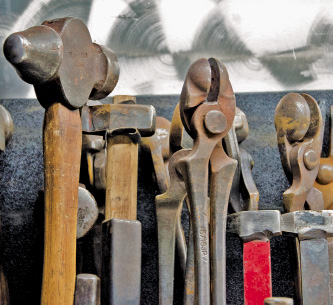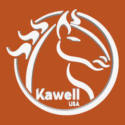Pictured Above: There are a number of tools that will make your job easier; however, not all of them are necessary to get the job done. Choose wisely to keep costs low.
Farrier Takeaways
- The tools that you need will be determined by the types of horses that you’ll be working on.
- Eliminate your mistakes first before buying high-quality tools. New farriers often wear them out quicker.
- Acquire tools that properly fit your hands to avoid repetitive injuries such as tendonitis.
What equipment do you really need to start earning a living as a farrier? Three highly successful farriers with insight into the tool industry offer their thoughts.
If you’ve learned fundamental hoof-care techniques, you’ve already made the most important acquisition, according to Dan Bradley.
“Knowledge and education are the first tools for a farrier,” says Bradley, a member of the International Horseshoeing Hall of Fame and a representative for GE Forge & Tool of Grover Beach, Calif.
As for hardware, Bradley says, “To go out and shoe a horse, you basically just need an anvil, a rounding hammer, a knife, a nipper or some kind of cutting tool, some nails and a driving hammer. That’s about it.”
But he also recommends a forge, fire tongs and flooring tools such as rasps and pull-offs.
“That’s what new farriers need,” he says. “They don’t need grinders and all the toys to start out with.”
Donald Jones, another member of the International Horseshoeing Hall of Fame and the long-time owner of NC Tool Co. in Pleasant Garden, N.C., offers a similar list for new farriers.
He recommends a hoof knife, nippers, rasp, clincher, driving hammer, rounding hammer, crease nail puller, clinch cutter, clinch block, pull-offs, a forge for modifying shoes, an anvil or a stall jack, an anvil stand with a spring vise and a hoof stand and cradle.
“If you’re going to shoe every day,” Jones says, “you need those tools to make the job easier.”
Tom McNew, who owns and operates Lookout Mountain School of Horseshoeing in Gadsden, Ala., with his son Lane, adds to the list. He says new farriers should get off on the right foot by using a hoof gauge and a wing divider — tools for measuring a hoof and properly fitting a shoe — and recommends a good apron and a toolbox on casters.
McNew, who began shoeing in 1960, remembers farriers treating all hooves alike during his early years. Now, student farriers are taught that every foot is different, he says, and accurate measurements help ensure well-fitting shoes.
“Imagine if a carpenter tried to build a house without a tape measure,” he says. “How would that turn out?”
Bradley says the tools new farriers need can be influenced by the horses they are working on.
“If they’re starting out on their own and soliciting work, they’re going to do a lot of backyard horses,” he says. “If they start out apprenticing or riding with somebody, it will depend on the discipline that person is doing, from Thoroughbreds to gaited horses or whatever. The young farrier will see what he or she needs to continue working in that field.”

High-quality tools will help a farrier work efficiently, but some less expensive brands will offer good quality for your new practice.
Beneficial, Not Crucial
Bradley says new farriers need to determine a realistic budget and stay within it. Jones agrees, noting that some tools might be desirable, but are not absolutely necessary while budgets are tight.
For example, Jones says, “You don’t have to have a clinch cutter, you can file the clinch off with a rasp, then pull the shoe. And you don’t need a clincher. You can clinch the nails with a hammer.
“You can just bend the nail over and flatten it against the hoof with a hammer, but that requires more skill than using a clincher. You’re hitting the side of the horse’s foot with a glancing blow, and you need to be really accurate.”
A new farrier can also do without a crease nail puller.
“You can take pull-offs, carefully work them under the shoe and raise the shoe a little bit,” Jones says. “That will pull the nail back out. Then you can pull it out with your shoe-puller. It takes a bit of skill to work the shoe up.”
An anvil is another item that isn’t truly necessary, according to Jones.
Tips To Save Money On Tools
Supply shops often give discounts for bulk purchases. It might make more sense to join with other farriers to form a buying co-op. If you have similar needs in supplies, you can combine your money to get the items you need, receiving the discount without shouldering the entire purchase cost.
Before you buy, determine whether the amount of supplies and the money tied up in the purchases are worth the discount. For instance, if you spend a significant amount and it takes more than a year to use that inventory, was the discount worth the negative effect on your cash flow?
Another consideration is to shop around online. When it’s time to buy, bring up the online suppliers you will normally use and click on everything on your shopping list. It will calculate your costs including shipping. When buying above a certain dollar amount, consumers often will find free or discounted shipping.
When buying online, be sure you’re doing so safely.
“Make sure that the payment section of the website is secured by one of the major companies such as VeriSign and Authorize.net,” says Bob Schantz, owner of Spanish Lake Blacksmith Shop in Foristell, Mo.
“You can use a stall jack,” he says. “The downside of that is you’re bent over, working low on a stall jack, as opposed to an anvil.”
Some farriers have both an anvil and a stall jack, which can be used to work around a horse while doing hoof work in a stall. “It has its place,” Jones says.
Although a hoof stand might not be necessary, Jones recommends them.
“I always used a hoof stand to set the front feet on. Some people just use their knee, but that takes a lot of skill and a lot of energy,” he says. “Now, there are hoof stands with cradles you can put on or take off. They’re nice to have; they can take some of the weight off you while you work.”
New farriers will be reassured to hear that they don’t need a large, expensive shoeing rig — just a vehicle that is neat and clean.
“It doesn’t really matter what you drive up in,” Bradley says. “People aren’t really impressed by that. But they will be impressed if they see you step out of a truck and 10 pounds of Taco Bell wrappers and two six-packs fall out. You need to show professionalism.”
Tool Recommendations
McNew says high-quality tools help a farrier work efficiently, but adds, “High-dollar tools are nice but are not always necessary.” That’s because, for some types of tools, less expensive brands often offer the same quality as more expensive options, he says.
However, he strongly recommends buying the highest-quality nippers you can find, regardless of the price.
“You need to be ready to trim that big horse with really hard feet,” he says.
To get the most from your tool investment, McNew suggests shopping at horseshoeing clinics, where tools are often on sale at sizable discounts.
Bradley offers a different approach to tool purchases.
“I suggest people start on the lower end and work their way up so they don’t destroy something that cost them a lot of money,” he says.
Bradley says new farriers “will most likely destroy everything they have. When they first start out, they tend to make mistakes. They’ll start out cutting wrong or sharpening a knife wrong, but they learn from their mistakes and learn how to do it right. Then they start moving into better quality equipment, from anvils to nippers.
Knowledge and education are the first tools for a farrier …
“When they do get into the better-quality equipment, it will last longer and make life easier working on horses,” Bradley says. “They’ll find that the high-quality equipment pays off in the long run for them.”
The good news is that new farriers on a tight budget don’t need to worry about starting out with substandard equipment, according to Jones, who began shoeing in the early 1960s.
“There are a lot of high-quality tools out there in different price ranges,” he says. “I don’t have a quarrel with any of the tools that are out there today. They’re superior to what they were in my early days. Nippers, pullers, rasps – they’re all state of the art now.”
Jones recommends focusing on acquiring tools that properly fit the farrier and his or her preferences. For example, he says he likes driving hammers with a long, slim handle and a weighted head that is heavier than the claw end.
“That gives you more velocity,” he says.
He also notes that most rounding hammers weigh 36 ounces, but he prefers a heavier model that weighs about 2.5 pounds.
“If you’re cold-shoeing, you need to go with a heavier hammer,” he says. “It will be easier on your wrist and arm. I’ve seen people using a pound-and-a-half hammer for cold shoeing, and that’s just not enough weight to move the metal. It’s hard on the person using it.”
Jones recommends an anvil in the 70-pound range, saying it’s easier to handle and will accommodate most shoeing tasks as well as larger anvils.
He suggests mounting an anvil on a stand, with the top of the anvil about even with your wrist when you stand straight up. That set-up helps farriers avoid raising the arm too high or needing to bend over when working on the anvil, thus saving wear and tear on their bodies over time.
Avoid working on an anvil set on a truck tailgate, Jones warns.
“That puts the anvil too high, and you’ll end up with tendonitis in your arm,” he says. “I can tell you that from experience. There were several of us in my area doing that, and every one of us got tendonitis. A little low is a lot better than too high.”
He also recommends using an anvil stand fitted with a foot pedal that operates a spring-loaded vise.
“That’s very handy for holding a shoe when you’re hot shoeing or want to use two hands to hold a drill or something like that,” Jones says.
What You Need To Get Started
You’re going to be working with a limited budget starting out. Yet, there is a basic set of tools you’ll need, whether you’re shoeing full- or part-time. The quality of your tools largely will depend on what you can afford.
Below is a list of the minimum tools you will need to trim and shoe horses. The price column represents the average mid-range cost. In many of these categories, there are tool options that fall higher and lower in cost.
These prices are averages taken from the mid-range priced items from three suppliers based in the East, South and West. The prices are rounded to the nearest dollar. The total doesn’t include sales tax or shipping costs.










